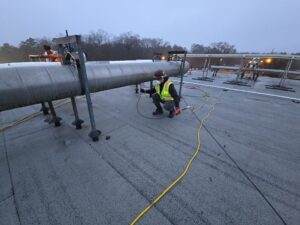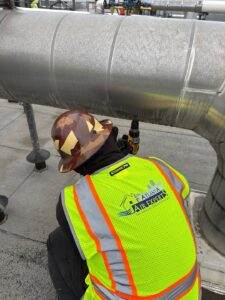Ever wondered why some homes feel fresher than others? Americans spend about 90% of their time indoors. It’s key to know how indoor air quality affects your health. Indoor air often has more pollutants than outdoor air, which can be harmful, mainly to kids, the elderly, and those with health issues.
Improving indoor air quality makes your home healthier. It also helps prevent respiratory and heart problems linked to bad air.
This guide will show you simple, cost-effective ways to improve your indoor air. You’ll learn how to make your home a cleaner, healthier place for everyone. Let’s explore practical tips to make your home a better space.
Knowing how important good indoor air quality is can really help your health. You’ll learn about ventilation, air purifiers, and more. Simple steps like changing HEPA filters and using green cleaning products can greatly improve your home’s air.
Want to know more about air quality and how to improve it? Read on for valuable tips and strategies at this detailed guide.
Key Takeaways
- Individuals spend about 90% of their time indoors, highlighting the importance of indoor air quality.
- Indoor air pollutants can be significantly more concentrated than outdoor pollutants, impacting health significantly.
- HEPA filters are essential in capturing allergens and pollutants; remember to replace them periodically.
- Proper ventilation plays a critical role in reducing indoor air pollutant concentrations.
- Switching to eco-friendly cleaning products can promote better indoor air quality.
- Regular air quality testing using DIY kits or professional services is highly recommended.
- Incorporating specific indoor plants can help absorb airborne toxins and improve air quality.
Understanding Indoor Air Quality: What It Means
Indoor air quality, or IAQ, is key to a healthy home. It’s about the air inside buildings and how it affects your health and comfort. Poor IAQ can cause health problems, from minor issues to serious respiratory diseases.
Many indoor pollutants are to blame. Knowing what these pollutants are helps us fight their effects.
Definition and Importance
Indoor air quality deals with many factors inside your home or office. Things like ventilation, humidity, and pollutants play a role. Good IAQ prevents health issues like headaches and serious diseases.
People spend most of their time indoors. So, knowing and managing indoor air quality is important for our health.
Common Air Pollutants
Many things can make indoor air bad. Particulate matter from cooking and dusting is one. Volatile organic compounds (VOCs) from paints and cleaners are another big problem.
Radon, a radioactive gas, can also get into homes. It’s a serious health risk. Other pollutants include CO₂ from appliances and human breathing, plus allergens like pet dander.
Mold and mildew, which grow in damp places, are also harmful. They can cause serious health issues if not controlled.
Sources of Indoor Air Pollution

It’s important to know the sources of indoor air pollution to keep our air clean. Many things can make our indoor air bad. Let’s look at these sources and how to lessen their effects.
Household Chemicals
Household chemicals like cleaners and air fresheners pollute our air. They release harmful gases called VOCs. These can harm our health in the short and long term.
Things like painting or burning candles also release VOCs. To improve the air, open windows and use natural cleaners.
Building Materials and Furnishings
New carpets and furniture can also pollute our air. They release harmful gases and particles. These are known as sources of indoor air pollution.
Materials like formaldehyde in plywood can make breathing harder. Choose low-emission materials and keep your air well-ventilated.
Biological Sources
Mold, pet dander, and insect droppings are also air pollutants. They can cause allergies and asthma. To fight these, clean often, use HEPA filters, and keep your air systems clean.
The Health Impacts of Poor Indoor Air Quality
It’s important to know how bad air inside can hurt us. We spend about 90% of our time indoors, like at home or work. The dangers of indoor pollution can be worse than outdoor pollution because it’s more concentrated inside.
This section will look at how bad air can harm us right away and over time. It’s all because of the pollutants we breathe in indoors.
Respiratory Issues
Bad air inside can cause breathing problems right away. Things like dust, mold, pollen, and chemicals can make asthma and other lung diseases worse. Kids and people with lung problems are more at risk.
In places like the Twin Cities, kids with asthma are hospitalized more often. This shows how important it is to have clean air inside.
Allergic Reactions
Bad air inside can also cause allergies. Pollutants like mold, pollen, and dust mites are common allergens. Studies in places like Quebec, Canada, show that dampness and mold can make asthma and infections worse in students.
These allergens can make you sneeze, cough, and itch. In serious cases, they can lead to long-term allergic diseases.
Long-term Health Risks
The dangers of bad air inside are serious over time. It can cause heart disease, lung cancer, and other serious problems. Radon, a common pollutant, is the second leading cause of lung cancer in the U.S.
Long-term exposure to fine particles can also increase heart attack and abnormal heart rhythm risks. People who are already at risk, like those who are poor or from minority groups, face even bigger health problems. This shows a big health gap that needs to be fixed.
How to Assess Your Indoor Air Quality
Keeping your home’s air clean and safe is key. You can do this by testing the air quality and checking your ventilation. It’s important to check often to keep your home healthy and fix any problems early.
Using Air Quality Monitors
Air quality monitors are essential for testing your indoor air. They show you levels of pollutants like carbon monoxide and radon. The Airthings View Plus, for example, tracks VOCs, CO2, and humidity.
Continuous radon monitors are also great. They give updates and warn you of dangerous levels. Devices like the Temptop M10 can find airborne particles and formaldehyde, making your home healthier.
Some monitors also check pressure, temperature, and more. They need calibration, which can take a week for VOC and CO2 sensors, or up to 30 days for radon. These tools help you spot pollution sources and act fast.
Evaluating Ventilation
Good ventilation is key to clean air. Checking your ventilation system makes sure fresh air gets in and bad air gets out. Older homes might need more checks because of VOCs from materials.
Newer homes usually follow better building codes, which helps air quality. To improve air flow, use exhaust fans in kitchens and bathrooms. Open windows often and make sure your HVAC works well. Regular maintenance and filter changes are also important for clean air.
Practical Tips for Improving Indoor Air Quality
Keeping your indoor air clean is key to a healthier home. By cleaning regularly, using good ventilation, and choosing natural products, you can breathe better indoors. Here are some easy tips to improve your indoor air quality.
Regular Cleaning and Dusting
Regular vacuuming and dusting help cut down on dust. Dust can harm your lungs, so it’s important to keep it low. Use a vacuum with a HEPA filter to catch small particles and allergens.
Don’t forget to clean hidden spots like under furniture and on top of cabinets. Keeping up with this cleaning can really help your air quality.
Proper Ventilation Techniques
Good ventilation brings fresh air into your home, reducing pollutants. Open windows and doors when you can to let in fresh air. Use exhaust fans in kitchens and bathrooms to remove moisture and pollutants.
Also, consider getting HEPA air purifiers. They help filter out airborne particles, making your air even cleaner.
Using Natural Products
Choosing natural products over chemical ones is healthier for your home. Many cleaning products release harmful VOCs. Instead, pick low or zero VOC paints and use natural cleaners like vinegar and baking soda.
These choices not only improve your air quality but also make your home more eco-friendly.
By following these simple steps, you can make your home a safer, healthier space. Cleaning with natural products and using good ventilation are easy ways to improve your indoor air quality.
The Role of Indoor Plants
Indoor plants add a touch of nature to your home and improve air quality. Some plants are great at removing toxins and pollutants. This makes them key for a healthier home.
Best Plants for Air Quality
NASA found some plants that clean the air well. Spider plants, snake plants, and peace lilies are top picks. They remove harmful stuff like carbon monoxide and formaldehyde from the air.
To really improve air quality, have one healthy plant in a 6- to 8-inch container for every 100 square feet.
Care and Maintenance
Keeping your plants healthy is important for clean air. They need regular watering, the right light, and sometimes food. Snake plants do well in low light and need water only when dry.
Peace lilies like indirect light and moist soil. Make sure they don’t dry out. Healthy plants clean the air better than sick ones.
Indoor plants can make a big difference in air quality. They can reduce pollutants and help with health issues like eye problems and headaches. A study in India found health benefits and even saved 15% on energy costs with more plants in offices.
By choosing and caring for the right indoor plants, you can make your home greener and healthier. This improves air quality and overall well-being.
Importance of Humidity Control
Keeping the right humidity levels is key for good indoor air quality. Changes in indoor humidity can affect health and comfort a lot.
Ideal Indoor Humidity Levels
Experts say the best indoor humidity is between 40-60% relative humidity (RH). This range stops respiratory problems and skin issues from low humidity. It also stops mold and dust mites from high humidity.
Staying in this range also lowers the survival of harmful bacteria and viruses. This makes your home healthier for you and your family.
Methods to Manage Humidity
There are many ways to control indoor humidity. Using dehumidifiers is one effective method. They help lower air moisture, which is great in humid places.
Humidifiers are good for dry places to add moisture. This prevents dry skin and eye problems.
It’s also smart to check indoor humidity with hygrometers. This lets you know if it’s off and fix it fast. Advanced humidifiers work with HVAC systems for better control and energy use.
By focusing on humidity control, you can make your indoor air better. This makes your home or workspace more comfortable and healthy. Using these methods helps your health and keeps your place in good shape.
HVAC Systems and Air Quality
Your HVAC system is key to a healthy indoor space. It’s not just about feeling comfortable; it’s about staying healthy too. Many buildings struggle to keep air quality up, which can harm people inside. So, let’s talk about keeping your HVAC system in great shape and picking the best filters.
Maintaining Your HVAC System
Keeping your HVAC system in good working order is vital. Issues like leaky ducts, dirty filters, and blocked condensers can hurt air quality and raise energy bills. Regular checks and cleaning, including filter replacements, are must-do tasks for clean air and energy savings.
Regular maintenance keeps your HVAC system running smoothly. It stops problems like bad air flow and saves money on energy. Make sure to use digital tools to monitor your system and train your team well. This way, your HVAC system will keep the air clean and everyone healthy.
Choosing the Right Filters
Picking the right HVAC filters is also super important. These filters catch dust, pollutants, and allergens, keeping them out of your air. Look for filters with a high MERV rating to catch even the smallest particles.
Keep your filters clean and change them often to keep the air clean. Choose filters that filter well but don’t slow down your system. The right filters are a simple way to improve your air quality.
In short, taking care of your HVAC system and picking the right filters are key to good air quality. Regular maintenance and smart filter choices keep everyone in your space healthy and comfortable. So, make air quality a top priority in your home or office.
Air Purifiers: Do They Help?
Air purifiers are key for keeping indoor air clean, helping those who are sensitive to pollutants. There are many types out there. It’s important to know what they do and their limits.
Types of Air Purifiers
There are many air purifiers, each with its own strengths. HEPA air purifiers are top-notch, catching 99.97% of particles as small as 0.3 microns. They’re great at removing allergens, dust, and other tiny particles.
Ionic air purifiers are good but not as strong against big particles like dust or pollen. UV purifiers kill bacteria and viruses with ultraviolet light but need regular upkeep. Electrostatic precipitators and filters with activated carbon target specific pollutants, like VOCs and smells.
Benefits and Limitations
Air purifiers, like those using air purification tech, are great at cutting down airborne pollutants. They help with allergy and breathing problems, making the air cleaner and healthier. For example, the Carrier Infinity air purifier can kill up to 99% of airborne viruses and bacteria.
But, air purifiers have their downsides. Their success depends on room size, pollutant types, and how well they’re kept. For example, electrostatic precipitators need regular cleaning as they get full of particles. HEPA purifiers are top-notch for particles but might not catch gas pollutants without extra filters.
In conclusion, air purifiers are vital for better indoor air. But, picking the right one and keeping it in good shape are essential for the best results.
Creating a Healthy Home Environment
Creating a healthy home environment is key for well-being. Good design considerations and ways to reduce indoor pollutants greatly improve indoor air quality.
Design Considerations
When designing your home, choose non-toxic materials and furniture. Use low-VOC paints and formaldehyde-free furniture. Natural floors like hardwood or bamboo are also good choices.
Think about more than looks. Make smart choices for a healthy home environment. Also, make sure your home gets enough fresh air. Use energy-efficient ventilation systems to keep air clean without losing comfort.
Limiting Exposure to Pollutants
Improving indoor air quality starts with cutting down on pollutants. Dust, pollen, mold, and pet dander are big culprits. Clean regularly to keep these at bay.
Change your AC filters every 2-3 months or as the maker says. This helps remove airborne pollutants. Air purifiers with HEPA filters can catch up to 99.97% of particles. This includes allergens and pollutants.
Balance fresh air from outside with indoor air quality. Keep humidity between 30-50% to stop mold and dust mites. Focus on these steps for a healthy home environment that supports your family’s health.
Seeking Professional Help
Keeping your indoor air clean is key for your health. While you can clean and use air purifiers, sometimes you need a pro. Knowing when to get help is vital for a safe home.
When to Consult an Expert
If you have ongoing health issues like allergies or asthma, get expert help. Mold can affect 10% of Americans, causing serious allergies. Also, carbon monoxide is deadly, killing about 400 people yearly in the U.S.
Experts can spot dangers like radon gas, which causes 21,000 lung cancer deaths each year. Indoor air often has 10 times more VOCs than outside. Getting a pro ensures you catch these risks.
Recommended Professionals for Air Quality Issues
For top-notch air quality checks, turn to HVAC pros, environmental consultants, and certified specialists. They can make your air up to 50% cleaner. Their tests are 20% more accurate than DIY kits.
These experts can find pollutants like radon, VOCs, and particles. They show you how polluted your air is and how to fix it. This is important because we spend 90% of our time indoors.
By knowing when to ask for help and who to ask, you can keep your home healthy. This ensures a better indoor air quality for you and your family.





